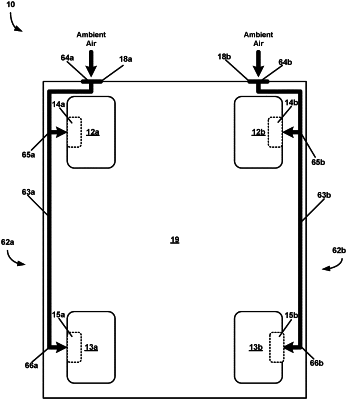| CPC B60T 5/00 (2013.01) [B62D 37/02 (2013.01); B62D 35/005 (2013.01)] | 18 Claims |

|
1. A vehicle brake cooling system, comprising:
a wireless network interface to receive, from one or more external source devices, wireless network data that includes one or more of the geographic map data, weather data, crowdsourced traffic data, and roadside sign data;
one or more a vehicle air vents moveable between a first position and a second position;
an air channel member defining an air circuit having an air inlet to receive ambient airflow in the second position of the vehicle air vents, and one or more air outlets that directs the ambient airflow to a front vehicle brake and a rear vehicle brake; and
one or more processors, to execute a set of instructions that cause the one or more processors to dynamically:
conduct, in response to a detection as sensor data one or more of a current position of the vehicle air vents, a current temperature of vehicle wheel brakes, and a current speed of the vehicle, a vehicle brake analysis of the sensor data;
receive the wireless network data; and
control, in response to the vehicle brake analysis and the wireless network data, the vehicle air vents between the first position to enhance the aerodynamic performance of the vehicle and the second position to selectively expose the air inlet.
|